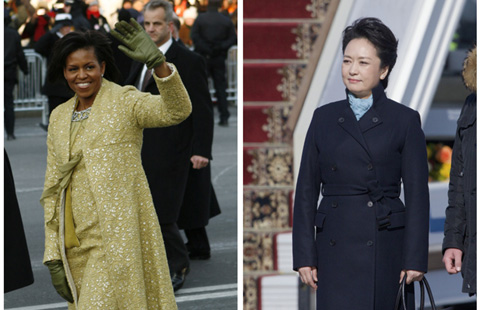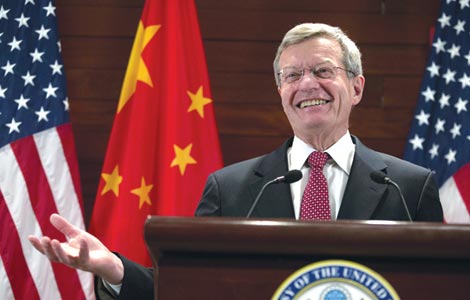China remains No 1 holder of US T-bill debt
Updated: 2014-03-19 11:07
By Michael Barris in New York (China Daily USA)
|
||||||||
China remained the largest holder of US debt in January, increasing its holdings for the first time in two months even as overall foreign demand for US Treasury securities weakened, according to new data from the Treasury Department.
Treasuries saw an outflow of $571 million at the start of the 2013, from an inflow of $17.9 billion in December. Foreign official institutions sold $16.7 billion in January and $11.9 billion in the final month of the year, data showed.
Analysts said they saw no significance in China's move to add $3.5 billion in Treasuries - less than 1 percent - for a total $1.274 trillion, despite weaker overall foreign buying. It was the first increase in holdings of US debt by China since it bought $12.2 billion worth in November.
"The two-month moving average of China's holdings is still a downtrend," Michael Woolfolk, senior market strategist at BNY Mellon in New York, said. "The Chinese have not been investing in US Treasuries at the level they had in the past."
Japan remained the second-biggest foreign US creditor, boosting its holdings 1.6 percent to $1.201 trillion.
The US government initially released a report Tuesday that showed total holdings declining in January, but a few hours later released a corrected version with changes.
January's figures were the latest example of how China's buying of US Treasuries has fluctuated in recent months amid what the nation's leadership says is an economic rebalancing toward consumer consumption and away from investment and exports.
John Praveen, chief investment strategist at Prudential International Investments Advisers, speculated late last year that China's once-robust purchases of US debt had tailed off because the economic transition had depleted resources.
"If you're not an export-driven economy and you are more of a consumer-driven economy, your exports will come down, your imports will increase, so your current account deficit will come down," Praveen said. "So they have less money to invest. It may be part of that overall strategy, of reducing how much money they put into the US Treasury market."
Since then, statistics have suggested that the rebalancing has yet to take hold, as investment accounted for more than half of the nation's economic activity last year.
David Dollar, a former US Treasury Department economist and financial emissary to China, said that although China's gross domestic product grew 7.7 percent in 2013, beating the government's 7.5 percent target, the nation's economy still hasn't seen the increases in domestic consumption and reduction in investment and exports that many economists say would set it on a sustainable course for growth.
Government data showed that capital formation accounted for 54 percent of China's economic growth last year, exceeding the 50 percent share taken up by consumption. Public investment accelerated during the second half of the year as the government sought to boost lower-than-expected growth from the first half of the year.
China's more muted approach to Treasury buying might also reflect a desire to diversify its holdings, Praveen has suggested.
Nevertheless, overall foreign demand for US Treasury securities is expected to remain strong in 2014, helped by the US Congress and the administration reaching an agreement in February that will put off any battle over raising the debt ceiling until March 2015.
The overall outflow in US Treasuries in January surprised observers since benchmark 10-year notes had their best monthly performance since mid-2012, ending the month with 10-year yields at 2.666 percent after starting at 3.038 percent.
Overall, demand for long-term US assets was $7.3 billion, a modest inflow compared with sales of $45.9 billion in December. Analysts said markets were expecting $40 billion in long-term inflow in January.
michaelbarris@chinadailyusa.com
(China Daily USA 03/19/2014 page1)

 Fashions of the first ladies
Fashions of the first ladies
 New US envoy hits ground running
New US envoy hits ground running
 HK cellist to perform at Carnegie Hall
HK cellist to perform at Carnegie Hall
 Skyscrapers in E China resemble LV check pattern
Skyscrapers in E China resemble LV check pattern
 President Xi honors memory of devoted county Party chief
President Xi honors memory of devoted county Party chief
 More than just food
More than just food
 Miss world visits cancer children in Colombia
Miss world visits cancer children in Colombia
 Chinese paintings exhibited at Sotheby's
Chinese paintings exhibited at Sotheby's
Most Viewed
Editor's Picks

|

|

|

|

|

|
Today's Top News
Tour adds 'new dimension' to Sino-US ties
China, largest holder of US debt
Russian forces take Ukraine naval HQ
Chinese treasures on the block
China must expand inbound tourism
California shelves proposal
Tourists offered compensation for bad air days
US first lady's China visit to boost relations
US Weekly

|

|






